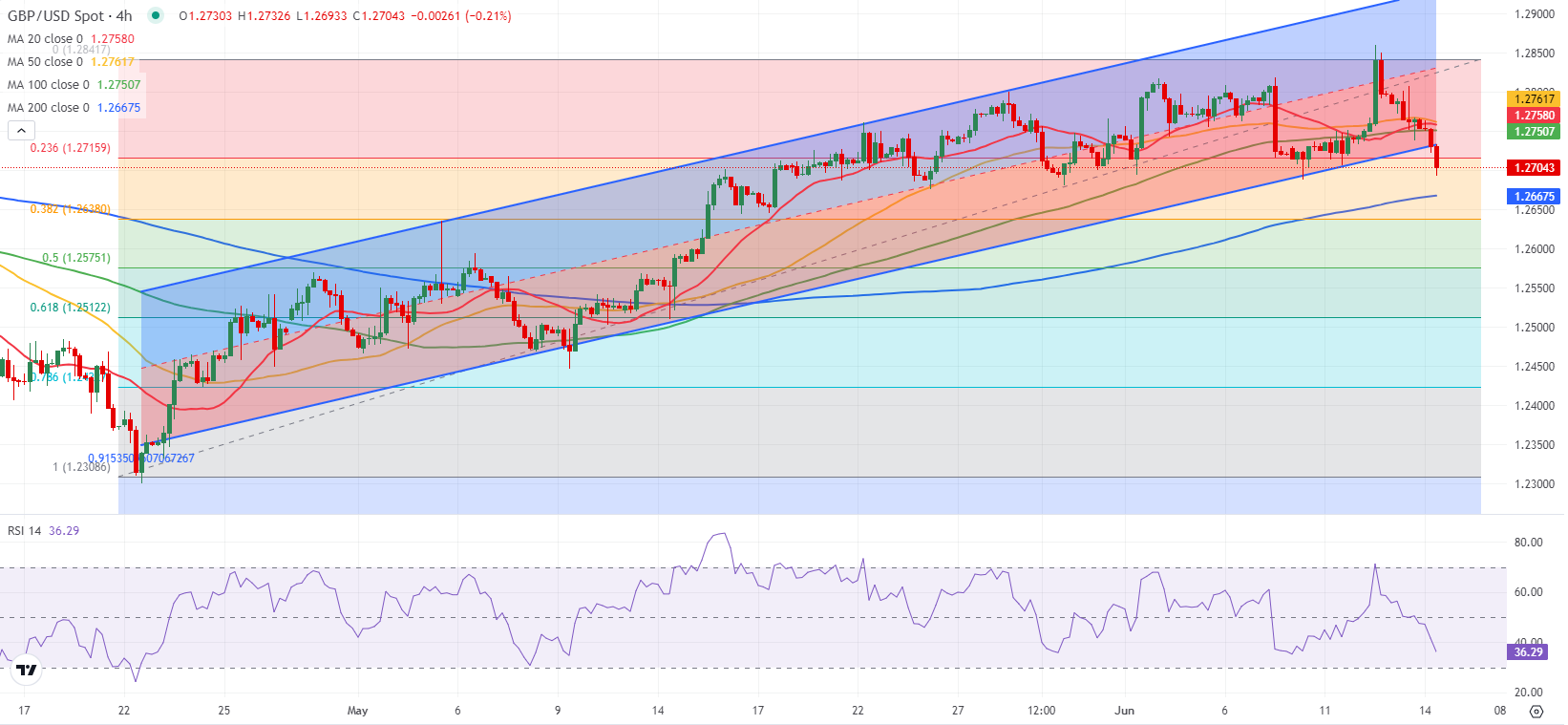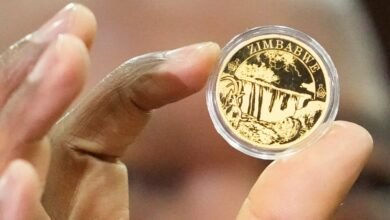Pound Sterling turns bearish as mood sours

- GBP/USD stays on the back foot and tests 1.2700 on Friday.
- The near-term technical outlook points to a bearish tilt.
- The USD could continue to benefit from the souring market mood.
GBP/USD closed in negative territory on Thursday and snapped a three-day winning streak. The pair struggles to hold its ground early Friday and tests 1.2700.
British Pound PRICE This week
The table below shows the percentage change of British Pound (GBP) against listed major currencies this week. British Pound was the weakest against the Swiss Franc.
| USD | EUR | GBP | JPY | CAD | AUD | NZD | CHF | |
|---|---|---|---|---|---|---|---|---|
| USD | 1.09% | 0.13% | 0.17% | -0.00% | -0.43% | -0.36% | -0.42% | |
| EUR | -1.09% | -0.61% | -0.67% | -0.83% | -1.23% | -1.18% | -1.24% | |
| GBP | -0.13% | 0.61% | 0.08% | -0.21% | -0.62% | -0.58% | -0.64% | |
| JPY | -0.17% | 0.67% | -0.08% | -0.16% | -0.67% | -0.64% | -0.54% | |
| CAD | 0.00% | 0.83% | 0.21% | 0.16% | -0.39% | -0.36% | -0.42% | |
| AUD | 0.43% | 1.23% | 0.62% | 0.67% | 0.39% | 0.05% | -0.02% | |
| NZD | 0.36% | 1.18% | 0.58% | 0.64% | 0.36% | -0.05% | -0.06% | |
| CHF | 0.42% | 1.24% | 0.64% | 0.54% | 0.42% | 0.02% | 0.06% |
The heat map shows percentage changes of major currencies against each other. The base currency is picked from the left column, while the quote currency is picked from the top row. For example, if you pick the British Pound from the left column and move along the horizontal line to the US Dollar, the percentage change displayed in the box will represent GBP (base)/USD (quote).
The US Dollar erased a portion of Wednesday losses in the European session on Thursday. Although the soft producer inflation data limited the USD’s rebound in the early American session, the souring risk mood helped the currency regather its strength later in the day.
Early Friday, safe-haven flows continue to dominate the financial markets, helping the USD continue to outperform its rivals. Additionally, the USD seems to be capturing capital outflows out of the Euro, which struggles to find demand amid political jitters, and the Japanese Yen, which stays under selling pressure following the Bank of Japan’s decision to hold policy settings unchanged.
The University of Michigan’s (UoM) Consumer Sentiment Survey will be featured in the US economic calendar on Friday. Investors, however, could continue to react to changes in risk perception heading into the weekend.
As of writing, US stock index futures were down between 0.65% and 0.1%. A bearish opening in Wall Street, followed by an extended slide, could further boost the USD and weigh on GBP/USD.
GBP/USD Technical Analysis
GBP/USD dropped below the lower limit of the ascending regression channel and the Relative Strength Index (RSI) indicator on the 4-hour chart fell below 40, reflecting the bearish tilt in the short term outlook.
On the downside, the 200-period Simple Moving Average (SMA) aligns as first support at 1.2670 before 1.2640 (Fibonacci 38.2% retracement) and 1.2600 (psychological level, static level).
If GBP/USD returns within the ascending channel by rising above 1.2730, sellers could be discouraged. In this case, 1.2750 (100-period SMA) could act as interim resistance before 1.2800 (psychological level, static level).
Pound Sterling FAQs
The Pound Sterling (GBP) is the oldest currency in the world (886 AD) and the official currency of the United Kingdom. It is the fourth most traded unit for foreign exchange (FX) in the world, accounting for 12% of all transactions, averaging $630 billion a day, according to 2022 data. Its key trading pairs are GBP/USD, aka ‘Cable’, which accounts for 11% of FX, GBP/JPY, or the ‘Dragon’ as it is known by traders (3%), and EUR/GBP (2%). The Pound Sterling is issued by the Bank of England (BoE).
The single most important factor influencing the value of the Pound Sterling is monetary policy decided by the Bank of England. The BoE bases its decisions on whether it has achieved its primary goal of “price stability” – a steady inflation rate of around 2%. Its primary tool for achieving this is the adjustment of interest rates. When inflation is too high, the BoE will try to rein it in by raising interest rates, making it more expensive for people and businesses to access credit. This is generally positive for GBP, as higher interest rates make the UK a more attractive place for global investors to park their money. When inflation falls too low it is a sign economic growth is slowing. In this scenario, the BoE will consider lowering interest rates to cheapen credit so businesses will borrow more to invest in growth-generating projects.
Data releases gauge the health of the economy and can impact the value of the Pound Sterling. Indicators such as GDP, Manufacturing and Services PMIs, and employment can all influence the direction of the GBP. A strong economy is good for Sterling. Not only does it attract more foreign investment but it may encourage the BoE to put up interest rates, which will directly strengthen GBP. Otherwise, if economic data is weak, the Pound Sterling is likely to fall.
Another significant data release for the Pound Sterling is the Trade Balance. This indicator measures the difference between what a country earns from its exports and what it spends on imports over a given period. If a country produces highly sought-after exports, its currency will benefit purely from the extra demand created from foreign buyers seeking to purchase these goods. Therefore, a positive net Trade Balance strengthens a currency and vice versa for a negative balance.
Source link






